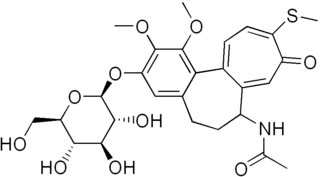
Pancuronium is an aminosteroid muscle relaxant with various medical uses. It is used in euthanasia and is used in some states as the second of three drugs administered during lethal injections in the United States.
An antispasmodic is a pharmaceutical drug or other agent that suppresses muscle spasms.
A muscle relaxant is a drug that affects skeletal muscle function and decreases the muscle tone. It may be used to alleviate symptoms such as muscle spasms, pain, and hyperreflexia. The term "muscle relaxant" is used to refer to two major therapeutic groups: neuromuscular blockers and spasmolytics. Neuromuscular blockers act by interfering with transmission at the neuromuscular end plate and have no central nervous system (CNS) activity. They are often used during surgical procedures and in intensive care and emergency medicine to cause temporary paralysis. Spasmolytics, also known as "centrally acting" muscle relaxant, are used to alleviate musculoskeletal pain and spasms and to reduce spasticity in a variety of neurological conditions. While both neuromuscular blockers and spasmolytics are often grouped together as muscle relaxant, the term is commonly used to refer to spasmolytics only.

Dantrolene sodium, sold under the brand name Dantrium among others, is a postsynaptic muscle relaxant that lessens excitation-contraction coupling in muscle cells. It achieves this by inhibiting Ca2+ ions release from sarcoplasmic reticulum stores by antagonizing ryanodine receptors. It is the primary drug used for the treatment and prevention of malignant hyperthermia, a rare, life-threatening disorder triggered by general anesthesia. It is also used in the management of neuroleptic malignant syndrome, muscle spasticity (e.g. after strokes, in paraplegia, cerebral palsy, or patients with multiple sclerosis), and poisoning by 2,4-dinitrophenol or by the related compounds dinoseb and dinoterb.

Guaifenesin, sold under the brand name Mucinex, among others, is a medication used as an expectorant, intended to help cough out phlegm from the airways. Chemically it is an ether of guaiacol and glycerine. It is unclear if it decreases coughing. Use is not recommended in children less than 6 years old. It is often used in combination with other medications. It is taken by mouth.

Cyclobenzaprine is a medication used for muscle spasms from musculoskeletal conditions of sudden onset. It is not useful in cerebral palsy. It is taken by mouth. Use is not recommended for more than a few weeks.

Curare is a common name for various plant extract alkaloid arrow poisons originating from indigenous peoples in Central and South America. Used as a paralyzing agent for hunting and for therapeutic purposes, Curare only becomes active by a direct wound contamination by a poison dart or arrow or via injection. These poisons function by competitively and reversibly inhibiting the nicotinic acetylcholine receptor (nAChR), which is a subtype of acetylcholine receptor found at the neuromuscular junction. This causes weakness of the skeletal muscles and, when administered in a sufficient dose, eventual death by asphyxiation due to paralysis of the diaphragm. Curare is prepared by boiling the bark of one of the dozens of plant alkaloid sources, leaving a dark, heavy paste that can be applied to arrow or dart heads. Historically, curare has been used as an effective treatment for tetanus or strychnine poisoning and as a paralyzing agent for surgical procedures.

Methocarbamol, sold under the brand name Robaxin among others, is a medication used for short-term musculoskeletal pain. It may be used together with rest, physical therapy, and pain medication. It is less preferred in low back pain. It has limited use for rheumatoid arthritis and cerebral palsy. Effects generally begin within half an hour. It is taken by mouth or injection into a vein.

Neuromuscular-blocking drugs block neuromuscular transmission at the neuromuscular junction, causing paralysis of the affected skeletal muscles. This is accomplished via their action on the post-synaptic acetylcholine (Nm) receptors.

Chlorzoxazone (INN) is a centrally acting muscle relaxant used to treat muscle spasm and the resulting pain or discomfort. It can also be administered for acute pain in general and for tension headache. It acts on the spinal cord by depressing reflexes. It is sold under the brand names Lorzone, Paraflex and Muscol and in combination form as Parafon Forte, a combination of chlorzoxazone and acetaminophen (paracetamol). Possible side effects include dizziness, lightheadedness, malaise, nausea, vomiting, and liver dysfunction. Used with acetaminophen it has added risk of hepatoxicity,.

Mephenesin (INN) is a centrally acting muscle relaxant. It can be used as an antidote for strychnine poisoning. Mephenesin however presents with the major drawbacks of having a short duration of action and a much greater effect on the spinal cord than the brain, resulting in pronounced respiratory depression at clinical doses and therefore a very low therapeutic index. It is especially dangerous and potentially fatal in combination with alcohol and other depressants. Mephenesin was used by Bernard Ludwig and Frank Berger to synthesize meprobamate, the first tranquilizer to see widespread clinical use. Mephenesin is no longer available in North America but is used in Italy and a few other countries. Its use has largely been replaced by the related drug methocarbamol, which is better absorbed.

Calciseptine (CaS) is a natural neurotoxin isolated from the black mamba Dendroaspis p. polylepis venom. This toxin consists of 60 amino acids with four disulfide bonds. Calciseptine specifically blocks L-type calcium channels, but not other voltage-dependent Ca2+ channels such as N-type and T-type channels.

Thiocolchicoside is a muscle relaxant with anti-inflammatory and analgesic effects. How it works is unknown, but it is believed to be via antagonism of nicotinic acetylcholine receptors. However, it is also appears to be a competitive antagonist of GABAA and glycine receptors. As such, it has powerful convulsant activity and should not be used in seizure-prone individuals.

Afloqualone (Arofuto) is a quinazolinone family GABAergic drug and is an analogue of methaqualone developed in the 1970s by a team at Tanabe Seiyaku. It has sedative and muscle-relaxant effects resulting from its agonist activity at the β subtype of the GABAa receptor and has had some clinical use, although it causes photosensitization as a side-effect that can cause skin problems such as dermatitis.

Camylofin is an antimuscarinic drug.

Coronaridine, also known as 18-carbomethoxyibogamine, is an alkaloid found in Tabernanthe iboga and related species, including Tabernaemontana divaricata for which it was named.

8-Phenyltheophylline (8-phenyl-1,3-dimethylxanthine, 8-PT) is a drug derived from the xanthine family which acts as a potent and selective antagonist for the adenosine receptors A1 and A2A, but unlike other xanthine derivatives has virtually no activity as a phosphodiesterase inhibitor. It has stimulant effects in animals with similar potency to caffeine. Coincidentally 8-phenyltheophylline has also been found to be a potent and selective inhibitor of the liver enzyme CYP1A2 which makes it likely to cause interactions with other drugs which are normally metabolised by CYP1A2.

Idrocilamide is a medication with skeletal muscle relaxant and anti-inflammatory actions used as a topical cream to treat lumbago and other kinds of muscular pain; it is available on prescription or over-the-counter in France and various other countries.

Inaperisone (INN) is a muscle relaxant.
Azemiopsin, a toxin obtained from the Azemiops feae viper venom, is a polypeptide that consists of 21 amino acid residues. It does not contain cysteine residues or disulfide bridges. The polypeptide can block skeletal muscle contraction by blocking nicotinic acetylcholine receptors.

















